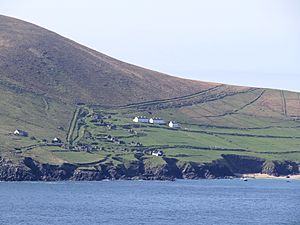Rinn an Chaisleáin facts for kids
Quick facts for kids Rinn an Chaisleáin |
|
|---|---|
| Castle Point | |

Great Blasket's lower village, with Castle Point in the foreground
|
|
| Type | castle site, cillín |
| Location | Great Blasket Island, County Kerry, Republic of Ireland |
| Official name: Rínn an Chaisleáin Church site | |
| Reference no. | 63 |
| Lua error in Module:Location_map at line 420: attempt to index field 'wikibase' (a nil value). | |
Rinn an Chaisleáin, also known as Castle Point, is a special historical place on Great Blasket Island in Ireland. It is recognized as a National Monument, which means it's protected because of its historical importance.
Contents
Where is Castle Point?
Rinn an Chaisleáin is found just north of the "Lower Village" on Great Blasket Island. It sits to the west of the island's harbor. Imagine looking out from the village towards the sea; Castle Point would be right there.
A Look at History: Castle Point's Past
The Ferriter Family and Their Castle
Around the late 1200s, a powerful family called the Feiritéar (or Ferriter) family lived in Ireland. They were Norman-Irish, meaning their ancestors were Normans who came to Ireland. This family rented the Blasket Islands from the Earls of Desmond. They paid for the islands with two hawks every year! Later, they rented the islands from the Boyle Earls of Cork.
Rinn an Chaisleáin was originally the spot where the Ferriter family built their castle. This castle was an important building for them on the island.
A School Built from Castle Stones
In 1840, a school was built using stones from the old castle ruins. This school was open for about 12 years before it closed in 1852. It's interesting to think that parts of an old castle were reused to build a new place for learning.
The Special Burial Ground
Rinn an Chaisleáin was also used as a special burial ground. It was a place where people were buried when they couldn't be taken to the mainland. Most island families had their main burial grounds in places like Dunquin or Ventry on the mainland. They wanted to be buried with their families there.
However, sometimes the weather was so bad that the island was cut off. Boats couldn't travel, and bodies couldn't be taken to the mainland for burial. In these difficult times, people would be buried at Rinn an Chaisleáin. It was also used for babies who had not been baptized and for sailors whose ships were wrecked nearby. Some of these burial spots are still marked by stones today.

